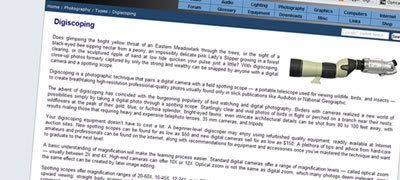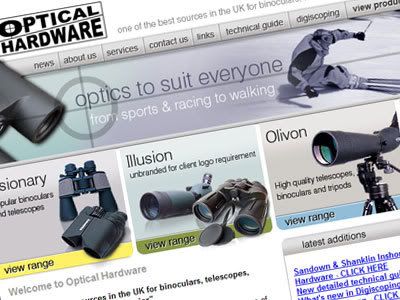I have been using the Nikon Coolpix 4500 ever since I started digiscoping in 2003. One of the best camera model for digiscoping at that time.

Preview based on a production Nikon Coolpix 4500, Firmware v1.1
The new Coolpix 4500 was announced on May 29th, 2002 as part of a trio of new Coolpix digital cameras from Nikon. It is the step up in resolution and features for the now distinctive split-bodied Coolpix design. The 4500 carries on from the 995 (although its neat design is more like the 950 / 990). This camera has a four megapixel CCD sensor, four times optical zoom lens, an all metallic body and flush fitting pop-up flash unit. The camera is noticeably smaller and narrower than the 990 and 995 thanks to the use of a Nikon's EN-EL1 Lithium-Ion rechargeable battery.
Many people will consider this camera to be the true upgrade to the 990, in each previous succession of split bodied Coolpix digital cameras we saw in increase in resolution (1.2, 1.92, 3.14 megapixels). The 995 however offered only a few new features and a 4x optical zoom lens. It wasn't the four megapixel Coolpix most were expecting, this camera is.
Regional differences
Note that we had a European Coolpix 4500 for this preview article. The Europe (and Canada) model has a red stripe on the hand grip (on the left above), the US model has a green stripe (on the right above), otherwise the two are identical. Personally I prefer the red stripe which is such a part of Nikon's design history.

Heritage
The Coolpix 900/900s
 The "9 series" range started back in 1998 with the 1.2 megapixel, 3x zoom, Nikon Coolpix 900 (E900), soon to be followed by the updated 900s (E910) this was the first time we saw the swivel design and also opened peoples eyes as to what a digital camera was capable of. I admit my first (real) digital camera was a Nikon Coolpix 900s.
The "9 series" range started back in 1998 with the 1.2 megapixel, 3x zoom, Nikon Coolpix 900 (E900), soon to be followed by the updated 900s (E910) this was the first time we saw the swivel design and also opened peoples eyes as to what a digital camera was capable of. I admit my first (real) digital camera was a Nikon Coolpix 900s.
The Coolpix 950
 In 1999 came the 1.92 megapixel, 3x zoom, Coolpix 950, a completely re-engineered camera of a quality over and above what we'd seen in the 900. It was well received by reviewers and owners alike, despite some shortcomings (chromatic aberrations and a few non-ergonomic functions) it soon became the de facto 2 megapixel digital camera (and is still used for comparison purposes today). Many other 2 megapixel digital cameras came, despite some very close competition (Olympus C-2000Z & C-2020Z) the Coolpix remained the favourite prosumer digital camera.
In 1999 came the 1.92 megapixel, 3x zoom, Coolpix 950, a completely re-engineered camera of a quality over and above what we'd seen in the 900. It was well received by reviewers and owners alike, despite some shortcomings (chromatic aberrations and a few non-ergonomic functions) it soon became the de facto 2 megapixel digital camera (and is still used for comparison purposes today). Many other 2 megapixel digital cameras came, despite some very close competition (Olympus C-2000Z & C-2020Z) the Coolpix remained the favourite prosumer digital camera.
The Coolpix 990
 In 2000 we saw the 3.14 megapixel, 3x zoom, Coolpix 990. Not just a step forward in resolution the 990 had improved ergonomics, better build quality and a raft of new "prosumer" features which delighted both Coolpix aficionado's and new buyers alike. The 990 saw the introduction of the 5-area spot AF, focus confirmation, a new aperture diaphragm, USB connectivity, sharpness control, histogram and highlighting, fine tuneable white balance and many more. The 990 soon established itself as the top 3 megapixel consumer digital, the one all other manufacturers aimed to beat.
In 2000 we saw the 3.14 megapixel, 3x zoom, Coolpix 990. Not just a step forward in resolution the 990 had improved ergonomics, better build quality and a raft of new "prosumer" features which delighted both Coolpix aficionado's and new buyers alike. The 990 saw the introduction of the 5-area spot AF, focus confirmation, a new aperture diaphragm, USB connectivity, sharpness control, histogram and highlighting, fine tuneable white balance and many more. The 990 soon established itself as the top 3 megapixel consumer digital, the one all other manufacturers aimed to beat.
The Coolpix 995
 2001 brought us the 3.14 megapixel, 4x zoom, Coolpix 995. Seen by many as an interim camera the 995 also stepped away from the 990's clean design to an arguably uglier and more complicated design. The 995 introduced several new features such as support for Compact Flash Type II (although not officially the IBM Microdrive) as well as the pop-up flash and a 4x optical zoom lens (which did come in for criticism by some). This evolution also saw the lens portion of the body changed from metal to plastic, again not a popular move with Nikonians.
2001 brought us the 3.14 megapixel, 4x zoom, Coolpix 995. Seen by many as an interim camera the 995 also stepped away from the 990's clean design to an arguably uglier and more complicated design. The 995 introduced several new features such as support for Compact Flash Type II (although not officially the IBM Microdrive) as well as the pop-up flash and a 4x optical zoom lens (which did come in for criticism by some). This evolution also saw the lens portion of the body changed from metal to plastic, again not a popular move with Nikonians.

www.dpreview.com - August 2002, Phil Askey










 The "9 series" range started back in 1998 with the 1.2 megapixel, 3x zoom, Nikon Coolpix 900 (E900), soon to be followed by the updated 900s (E910) this was the first time we saw the swivel design and also opened peoples eyes as to what a digital camera was capable of. I admit my first (real) digital camera was a Nikon Coolpix 900s.
The "9 series" range started back in 1998 with the 1.2 megapixel, 3x zoom, Nikon Coolpix 900 (E900), soon to be followed by the updated 900s (E910) this was the first time we saw the swivel design and also opened peoples eyes as to what a digital camera was capable of. I admit my first (real) digital camera was a Nikon Coolpix 900s. In 1999 came the 1.92 megapixel, 3x zoom, Coolpix 950, a completely re-engineered camera of a quality over and above what we'd seen in the 900. It was well received by reviewers and owners alike, despite some shortcomings (chromatic aberrations and a few non-ergonomic functions) it soon became the de facto 2 megapixel digital camera (and is still used for comparison purposes today). Many other 2 megapixel digital cameras came, despite some very close competition (Olympus C-2000Z & C-2020Z) the Coolpix remained the favourite prosumer digital camera.
In 1999 came the 1.92 megapixel, 3x zoom, Coolpix 950, a completely re-engineered camera of a quality over and above what we'd seen in the 900. It was well received by reviewers and owners alike, despite some shortcomings (chromatic aberrations and a few non-ergonomic functions) it soon became the de facto 2 megapixel digital camera (and is still used for comparison purposes today). Many other 2 megapixel digital cameras came, despite some very close competition (Olympus C-2000Z & C-2020Z) the Coolpix remained the favourite prosumer digital camera. In 2000 we saw the 3.14 megapixel, 3x zoom, Coolpix 990. Not just a step forward in resolution the 990 had improved ergonomics, better build quality and a raft of new "prosumer" features which delighted both Coolpix aficionado's and new buyers alike. The 990 saw the introduction of the 5-area spot AF, focus confirmation, a new aperture diaphragm, USB connectivity, sharpness control, histogram and highlighting, fine tuneable white balance and many more. The 990 soon established itself as the top 3 megapixel consumer digital, the one all other manufacturers aimed to beat.
In 2000 we saw the 3.14 megapixel, 3x zoom, Coolpix 990. Not just a step forward in resolution the 990 had improved ergonomics, better build quality and a raft of new "prosumer" features which delighted both Coolpix aficionado's and new buyers alike. The 990 saw the introduction of the 5-area spot AF, focus confirmation, a new aperture diaphragm, USB connectivity, sharpness control, histogram and highlighting, fine tuneable white balance and many more. The 990 soon established itself as the top 3 megapixel consumer digital, the one all other manufacturers aimed to beat. 2001 brought us the 3.14 megapixel, 4x zoom, Coolpix 995. Seen by many as an interim camera the 995 also stepped away from the 990's clean design to an arguably uglier and more complicated design. The 995 introduced several new features such as support for Compact Flash Type II (although not officially the IBM Microdrive) as well as the pop-up flash and a 4x optical zoom lens (which did come in for criticism by some). This evolution also saw the lens portion of the body changed from metal to plastic, again not a popular move with Nikonians.
2001 brought us the 3.14 megapixel, 4x zoom, Coolpix 995. Seen by many as an interim camera the 995 also stepped away from the 990's clean design to an arguably uglier and more complicated design. The 995 introduced several new features such as support for Compact Flash Type II (although not officially the IBM Microdrive) as well as the pop-up flash and a 4x optical zoom lens (which did come in for criticism by some). This evolution also saw the lens portion of the body changed from metal to plastic, again not a popular move with Nikonians.